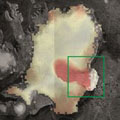Rapid ice loss in a remote Arctic ice cap has been detected by the Sentinel-1A and CryoSat satellites.
Rapid ice loss in a remote Arctic ice cap has been detected by the Sentinel-1A and CryoSat satellites.
Located on Norway's Nordaustlandet island in the Svalbard archipelago, parts of the Austfonna ice cap have thinned by more than 50 m since 2012 - about a sixth of the ice's thickness.
Over the last two decades, ice loss from the southeast region of Austfonna has increased significantly, and ice thinning has spread over 50 km inland and is now within 10 km of the summit.
The ice cap's outlet glacier is also flowing 25 times faster, from 150 m to 3.8 km per year - half a metre per hour.
In the study published in Geophysical Research Letters, a team led by scientists from the Centre for Polar Observation and Modelling (CPOM) at the University of Leeds in the UK combined observations from eight satellite missions, including Sentinel-1A and CryoSat, with results from regional climate models.
"These results provide a clear example of just how quickly ice caps can evolve, and highlight the challenges associated with making projections of their future contribution to sea level," said the study's lead author, Dr Mal McMillan.
